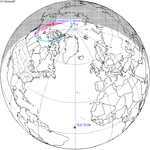Solar eclipse of November 12, 1928
| Solar eclipse of November 12, 1928 | |
|---|---|
| Type of eclipse | |
| Nature | Partial |
| Gamma | 1.0861 |
| Magnitude | 0.8078 |
| Maximum eclipse | |
| Coordinates | 62°36′N 81°06′E / 62.6°N 81.1°E |
| Times (UTC) | |
| Greatest eclipse | 9:48:24 |
| References | |
| Saros | 122 (53 of 70) |
| Catalog # (SE5000) | 9348 |
A partial solar eclipse occurred on November 12, 1928. A solar eclipse occurs when the Moon passes between Earth and the Sun, thereby totally or partly obscuring the image of the Sun for a viewer on Earth. A partial solar eclipse occurs in the polar regions of the Earth when the center of the Moon's shadow misses the Earth.
Related eclipses
Solar eclipses 1928–1931
This eclipse is a member of a semester series. An eclipse in a semester series of solar eclipses repeats approximately every 177 days and 4 hours (a semester) at alternating nodes of the Moon's orbit.[1]
The partial solar eclipse on June 17, 1928 occurs in the previous lunar year eclipse set, and the partial solar eclipse on September 12, 1931 occurs in the next lunar year eclipse set.
| Solar eclipse series sets from 1928 to 1931 | ||||||
|---|---|---|---|---|---|---|
| Ascending node | Descending node | |||||
| Saros | Map | Gamma | Saros | Map | Gamma | |
| 117 | May 19, 1928 Total (non-central) |
1.0048 | 122 | November 12, 1928 Partial |
1.0861 | |
| 127 | May 9, 1929 Total |
−0.2887 | 132 | November 1, 1929 Annular |
0.3514 | |
| 137 | April 28, 1930 Hybrid |
0.473 | 142 | October 21, 1930 Total |
−0.3804 | |
| 147 | April 18, 1931 Partial |
1.2643 | 152 | October 11, 1931 Partial |
−1.0607 | |
Metonic series
The metonic series repeats eclipses every 19 years (6939.69 days), lasting about 5 cycles. Eclipses occur in nearly the same calendar date. In addition, the octon subseries repeats 1/5 of that or every 3.8 years (1387.94 days).
| 22 eclipse events, progressing from north to south between April 8, 1902 and August 31, 1989: | ||||
|---|---|---|---|---|
| April 7–8 | January 24–25 | November 12 | August 31-September 1 | June 19–20 |
| 108 | 114 | 116 | ||
 April 8, 1902 |
 August 31, 1913 |
 June 19, 1917 | ||
| 118 | 120 | 122 | 124 | 126 |
 April 8, 1921 |
 January 24, 1925 |
 November 12, 1928 |
 August 31, 1932 |
 June 19, 1936 |
| 128 | 130 | 132 | 134 | 136 |
 April 7, 1940 |
 January 25, 1944 |
 November 12, 1947 |
 September 1, 1951 |
 June 20, 1955 |
| 138 | 140 | 142 | 144 | 146 |
 April 8, 1959 |
 January 25, 1963 |
 November 12, 1966 |
 August 31, 1970 |
 June 20, 1974 |
| 148 | 150 | 152 | 154 | |
 April 7, 1978 |
 January 25, 1982 |
 November 12, 1985 |
 August 31, 1989 | |
References
- ^ van Gent, R.H. "Solar- and Lunar-Eclipse Predictions from Antiquity to the Present". A Catalogue of Eclipse Cycles. Utrecht University. Retrieved 6 October 2018.
External links
- Earth visibility chart and eclipse statistics Eclipse Predictions by Fred Espenak, NASA/GSFC




